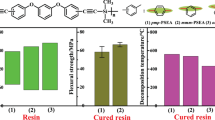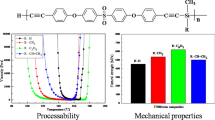Abstract
A study of the rates and mechanisms of degradation of an acetylene terminated sulfone resin, more precisely, bis[4-(3-ethynyl phenoxy) phenyl] sulfone and its higher oligomers, under high vacuum conditions, and under a flowing atmosphere of nitrogen, was made using techniques such as programmed thermogravimetry (TG), Thermal Volatilization Analysis (TVA), and Sub Ambient Thermal Volatilization Analysis (SATVA). Gravimetric product analyses made in conjunction with quantitative Infrared and Nuclear Magnetic Resonance Spectroscopy were used to develop a quantitative product distribution for the process. By so doing, we established the sulfone residue as the thermal weak link in the system, and identified two overlapping processes of backbone polyphenylether thermal decomposition; a low temperature process involving scissions promoted by the sulfone moiety, and a higher temperature process involving more random scissions of residual sulfone free polyphenylethers.
Zusammenfassung
Mittels TG, TVA und SATVA wurde eine Untersuchung der Reaktionsgeschwindigkeit und des Reaktionsmechanismus des Abbaues von Sulfonharz mit endständigem Acetylen (von bis-[4-(3-ethinylphenoxy)phenyl]sulfon und seiner höheren Oligomere) im Hochvakuum bzw. in einer dynamischen Stickstoffatmosphäre durchgeführt. In Verbindung mit quantitativer IR- und NMR-Spektroskopie wurde eine gravimetrische Analyse der Produkte erstellt, um eine quantitative Produktezusammensetzung des Prozesses zu erhalten. Der Sulfonrest konnte somit als schwaches Kettenglied des Systemes erkannt und zwei überlappende Prozesse der thermischen Zersetzung des hauptkettigen Polyphenylethers identifiziert werden: ein Prozess bei niedrigerer Temperatur beinhaltet durch die Sulfonkomponente geförderte Spaltungen und ein zweiter Prozess verursacht bei höherer Temperatur Random-Spaltungen des verbleibenden sulfonfreien Polyphenylethers.
Similar content being viewed by others
References
H. Lee and K. Neville, “Handbook of Epoxy Resins”, McGraw Hill, 1967.
P. J. Flory, “Principles of Polymer Chemistry”, Cornell University Press, Ithaca, NY, 1953.
J. J. Harrison and C. M. Selwitz, AFML-TR-79-4183.
T. G. Pearson and P. L. Robinson, J. Chem. Soc., (1932), 660.
I. C. McNeill, Europ. Polym. J., 6 (1970) 373.
I. C. McNeill, Europ. Polym. J., 3 (1967) 409.
I.C. McNeill, and W.T.K. Stevenson, Polym. Deg. and Stability, 10 (1985) 247.
I.C. McNeill, in “Developments in Polymer Degradation-1”, N. Grassie (Ed.), Applied Science Publishers, London 1977, p. 43.
J. Yarwood, “High vacuum Techniques”, Fourth Ed., Chapman and Hall, London, 1967.
W.T.K. Stevenson and I. J. Goldfarb, “Characterization of Acetylene Terminated Sulfone Resin: Part I”, J. Appl. Polym. Sci., (in press).
Author information
Authors and Affiliations
Additional information
W.T.K. Stevenson would like to acknowledge the financial assistance of the National Research Council who funded a Research Associateship at Wright Patterson Air Force Base for the duration of this work. In addition, both authors would like to offer thanks to Mr. J. Heines for his sound technical assistance, and to Mr. R. Grant who fabricated most of the glassware described here.
Rights and permissions
About this article
Cite this article
Stevenson, W.T.K., Goldfarb, I.J. Degradation of an acetylene terminated sulfone (ATS) resin. Journal of Thermal Analysis 36, 2643–2665 (1990). https://doi.org/10.1007/BF01913661
Received:
Revised:
Issue Date:
DOI: https://doi.org/10.1007/BF01913661




